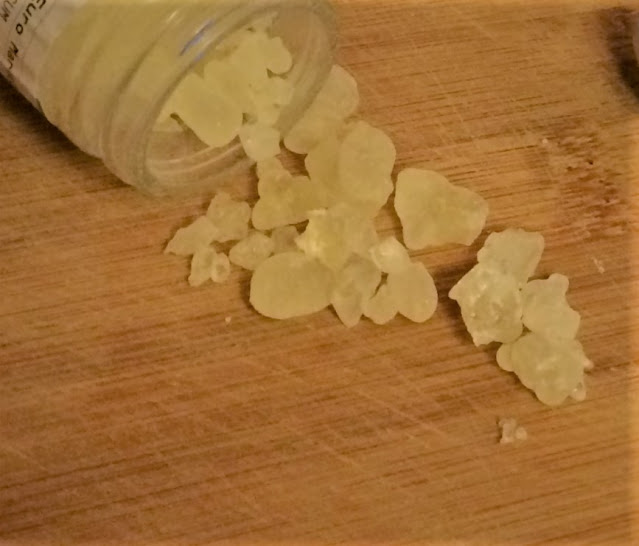Mastic is harvested from the sap of the broadleaf evergreen mastic tree. This tree is endemic to the Greek island of Chios (birthplace of the poet Homer), and it has been cultivated there in large numbers since antiquity. Its crop is valued internationally, and for that reason, it has made the island of Chios famous. Homer and mastic: it doesn't get any better!
Today mastic is used in folk medicine preparations and more importantly as a flavouring in food and spirits. It is also an ingredient in Chrism or Myrrh, the consecrated oil used by the Orthodox, Roman, and Anglican churches.
To harvest mastic, incisions are made in the bark of the trunk and branches of the tree. From these incisions, a resin begins to appear. It is pea-sized, globular and translucent, and it is commonly referred to as “tears.” As the resin begins to fall to the ground the tree is said to be “weeping.”
The resin really does look like tears!
Below is a photograph of an older mastic tree. The expertly placed cuts in its trunk are visible in the closeup of the photo.
Here a harvester is scoring the trunk of a mastic tree. The harvester must be covered with clean clothing from head to toe so that no impurities such as hair or sweat fall on the white soil surrounding the tree.
Calcium carbonate has multiple uses. It's used as an antacid and as a calcium dietary supplement. In the case of mastic harvesting, it's spread on the soil to help the mastic resin solidify when it falls to the ground. CaCO3 is inert and doesn't affect the properties of the resin. Furthermore, it must be used because its white colour preserves the clarity of the resin. If the soil is on the dark side, then the resin itself turns dark and is not marketable.
Mastic for flavouring is sold in airtight containers that contain small pieces of mastic tears. Before using them in recipes these tears must be pulverized into powder form. To make powdered mastic, a mortar and pestle are used to pound the resin. It is easier to smash it by adding a little sugar or salt. Mastic flavour is slightly sweet and reminiscent of cedar.
Historically one of the more popular uses of mastic was to chew it in order to freshen the breath. Thus, it was given the name mastic, which derives from a Greek verb meaning to chew. The English verb masticate derives from the same root, and the Greek word for chewing gum is “mastiha.”
As a young child growing up in Greece, I remember that I could buy a small package of about 3 pieces of "mastiha from Chios" for the cost of half a drachma, which back then amounted to less than a U.S. penny. I could afford it better than the tiny box of minty chicklets which cost one whole drachma. So I would chew my gum from Chios, carefully at first because its texture was hard at the outset. Soon it would take on a gummy consistency and it would release its distinct freshening flavour which would last for a good half hour. Then it would be time to discard it and buy some more. Alas, I gave up chewing it when I discovered bubble gum!
Mastic gum flavouring can be purchased locally in speciality Greek or Middle Eastern stores or it can be gotten through the internet.
Here's some mastic placed next to its frequent companion, mahlepi. The two flavourings are a popular duo in recipes of the Greek Easter bread known as Tsoureki.









